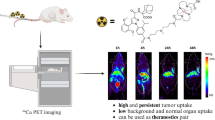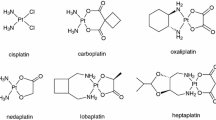Abstract
Two mononuclear Pt(II) compounds, [Pt(BQL1)Cl]Cl (BQL1-Pt) and [Pt(BQL2)Cl]Cl (BQL2-Pt), with [5-(benzo[4,5]furo[3,2-b]quinolin-11-yloxy)-pentyl]-bis-pyridin-2-ylmethyl-amine (BQL1) and [9-(benzo[4,5]furo[3,2-b]quinolin-11-yloxy)-nonyl]-bis-pyridin-2-ylmethyl-amine (BQL2), were prepared as new chemotypes for potential antitumor agents. In this study, the effects of cryptolepine derivatives in BQL1-Pt, 2,2′-dipicolylamine Pt(II) complex, and BQL2-Pt on cellular Pt(II) accumulation, cytotoxicity, and in vitro and in vivo antitumor activities against T-24 cancer cells and normal HL-7702 cells were evaluated. BQL1-Pt and BQL2-Pt displayed cytotoxic activities in the micromolar range (1.3 ± 0.1 and 0.2 ± 0.2 μM, respectively) on T-24 cancer cells; however, they did not exhibit any toxicity against HL-7702 cells. They triggered T-24 cell apoptosis through a mitochondrial dysfunction pathway. BQL1-Pt and BQL2-Pt prepared from the neutral BQL1 and BQL2 ligands with cryptolepine derivatives showed better antitumor activities than 2,2′-dipicolylamine. Furthermore, BQL2-Pt effectively inhibited the growth of bladder T-24 tumor in vivo. BQL2-Pt could be a potential therapeutic candidate for cancers.




Similar content being viewed by others
References
Mohapatra RK, El‑ajaily MM, Alassbaly FS, Sarangi AK, Das D, Maihub AA, et al. DFT, anticancer, antioxidant and molecular docking investigations of some ternary Ni(II) complexes with 2‑[(E)‑[4‑(dimethylamino) phenyl]methyleneamino]phenol. Chem Pap. 2021;75:1005–19.
Nam JS, Kang MG, Kang J, Park SY, Lee SJ, Kim HT, et al. Endoplasmic reticulum-localized iridium(III) complexes as efficient photodynamic therapy agents via protein modifications. J Am Chem Soc. 2016;138:10968–77.
Mohapatra RK, Das PK, Pradhan MK, El-Ajaily MM, Das D, Salem HF, et al. Recent advances in urea- and thiourea-based metal complexes: biological, sensor, optical, and corroson inhibition studies. Comments Inorg Chem. 2019;39:127–87.
Nam E, Han J, Suh JM, Yi Y, Lim MH. Link of impaired metal ion homeostasis to mitochondrial dysfunction in neurons. Curr Opin Chem Biol. 2018;43:8–14.
El-ajaily MM, Sarangi AK, Mohapatra RK, Hassan SS, Eldaghare RN, Mohapatra PK. et al. Transition metal complexes of (E)-2((2-hydroxybenzylidene)amino-3-mercaptopropanoic acid: XRD, anticancer, molecular modeling andmolecular docking studies. Chemistry Select. 2019;2019:9999–10005.
Vernooij RR, Joshi T, Horbury MD, Graham B, Izgorodina EI, Stavros VG, et al. Spectroscopic studies on photoinduced reactions of the anticancer prodrug, trans, trans, trans-[Pt(N3)2(OH)2(py)2]. Chem- Eur J 2018;24:5790–803.
Ouyang C, Chen L, Rees TW, Chen Y, Liu J, Ji LN, et al. A mitochondria-targeting hetero-binuclear Ir(III)-Pt(II) complex induces necrosis in cisplatin-resistant tumor cells. Chem Commun. 2018;54:6268–71.
Fong TTH, Lok CN, Chung CYS, Fung YME, Chow PK, Wan PK, et al. Cyclometalated palladium(II) N-heterocyclic carbene complexes: anticancer agents for potent in vitro cytotoxicity and in vivo tumor growth suppression. Angew Chem Int Ed. 2016;55:11935–9.
Wang X, Wang X, Jin S, Muhammad N, Guo Z. Stimuli-responsive therapeutic metallodrugs. Chem Rev. 2018;119:1138–92.
Pracharova J, Saltarella T, Radosova Muchova T, Scintilla S, Novohradsky V, Novakova O, et al. Novel antitumor cisplatin and transplatin derivatives containing 1-methyl-7-azaindole: synthesis, characterization, and cellular responses. J Med Chem. 2015;58:847–59.
Wurtenberger I, Angermaier B, Kircher B, Gust R. Synthesis and in vitro pharmacological behavior of platinum(II) complexes containing 1,2-diamino-1-(4-fluorophenyl)-2-alkanol ligands. J Med Chem. 2013;56:7951–64.
Wang Q, Huang Z, Ma J, Lu X, Zhang L, Wang X, et al. Design, synthesis and biological evaluation of a novel series of glycosylated platinum(IV) complexes as antitumor agents. Dalton Trans. 2016;45:10366–74.
Senerovic L, Zivkovic MD, Veselinovic A, Pavic A, Djuran MI, Rajkovic S, et al. Synthesis and evaluation of series of diazine-bridged dinuclear platinum(II) complexes through in vitro toxicity and molecular modeling: correlation between structure and activity of Pt(II) complexes. J Med Chem. 2015;58:1442–51.
Chtchigrovsky M, Eloy L, Jullien H, Saker L, Ségal-Bendirdjian E, Poupon J, et al. Antitumortrans-N-heterocyclic carbene–amine–Pt(II) complexes: synthesis of dinuclear species and exploratory investigations of DNA binding and cytotoxicity mechanisms. J Med Chem. 2013;56:2074–86.
Qin QP, Wang ZF, Wang SL, Luo DM, Zou BQ, Yao PF, et al. In vitro and in vivo antitumor activities of three novel binuclear platinum(II) complexes with 4′-substituted-2,2′:6′,2″-terpyridine ligands. Eur J Med Chem. 2019;170:195–202.
Qin QP, Wang ZF, Huang XL, Tan MX, Shi BB, Liang H. High in vitro and in vivo tumor-selective novel ruthenium(II) complexes with 3-(2′-benzimidazolyl)-7-fluoro-coumarin. ACS Med Chem Lett. 2019;10:936–40.
Qin QP, Wang ZF, Huang XL, Tan MX, Zou BQ, Liang H. Strong in vitro and vivo cytotoxicity of novel organoplatinum(II) complexes with quinoline-coumarin derivatives. Eur J Med Chem. 2019;184:111751.
Chen ZF, Qin QP, Qin JL, Liu YC, Huang KB, Li YL, et al. Stabilization of G-quadruplex DNA, inhibition of telomerase activity, and tumor cell apoptosis by organoplatinum(II) complexes with oxoisoaporphine. J Med Chem. 2015;58:2159–79.
Chen ZF, Qin QP, Qin JL, Zhou J, Li YL, Li N, et al. Water-soluble ruthenium(II) complexes with Chiral 4-(2,3-Dihydroxypropyl)-formamide oxoaporphine (FOA): in vitro and in vivo anticancer activity by stabilization of G-quadruplex DNA, inhibition of telomerase activity, and induction of tumor cell apoptosis. J Med Chem. 2015;58:4771–89.
Deng Y, Zhang M, Luo H. Identification and antimicrobial activity of two alkaloids from traditional Chinese medicinal plant Tinospora capillipes. Ind Crops Prod. 2012;37:298–302.
Qin QP, Zou BQ, Wang ZF, Huang XL, Zhang Y, Tan MX, et al. High in vitro and in vivo antitumor activities of luminecent platinum(II) complexes with jatrorrhizine derivatives. Eur J Med Chem. 2019;183:111727.
Qin QP, Wang ZF, Huang XL, Tan MX, Luo ZH, Wang SL, et al. Two telomerase-targeting Pt(II) complexes of jatrorrhizine and berberine derivatives induce apoptosis in human bladder tumor cells. Dalton Trans. 2019;48:15247–54.
Pettinari R, Marchetti F, Di Nicola C, Pettinari C, Cuccioloni M, Bonfili L, et al. Novel osmium(II)–cymene complexes containing curcumin and bisdemethoxycurcumin ligands. Inorg Chem Front. 2019;6:2448–57.
Banerjee S, Chakravarty AR. Metal complexes of curcumin for cellular imaging, targeting, and photoinduced anticancer activity. Acc Chem Res. 2015;48:2075–83.
Wanninger S, Lorenz V, Subhan A, Edelmann FT. Metal complexes of curcumin–synthetic strategies, structures and medicinal applications. Chem Soc Rev. 2015;44:4986–5002.
Huang S, Xie J, Su W, Liu Y, Wang X, Hu B, et al. Comparative investigation of interactions between two ruthenium(II) arene PTA type complexes with curcuminoid ligands and human serum albumin. J Organomet Chem. 2017;853:81–92.
Yin R, Zhang M, Hao C, Wang W, Qiu P, Wan S, et al. Different cytotoxicities and cellular localizations of novel quindoline derivatives with or without boronic acid modifications in cancer cells. Chem Commun. 2013;49:8516–18.
Ou TM, Lin J, Lu YJ, Hou JQ, Tan JH, Chen SH, et al. Inhibition of cell proliferation by quindoline derivative (SYUIQ-05) through its preferential interaction with c-myc promoter G-quadruplex. J Med Chem. 2011;54:5671–9.
Qin QP, Wei ZZ, Wang ZF, Huang XL, Tan MX, Zou HH, et al. Imaging and therapeutic applications of Zn(II)-cryptolepine-curcumin molecular probes in cell apoptosis detection and photodynamic therapy. Chem Commun. 2020;56:3999–4002.
Qin LQ, Liang CJ, Zhou Z, Qin QP, Wei ZZ, Tan MX, et al. Mitochondria-localizing curcumin-cryptolepine Zn(II) complexes and their antitumor activity. Bioorgan Med Chem. 2021;30:115948.
Meng T, Qin QP, Chen ZL, Zou HH, Wang K, Liang FP. Discovery of high in vitro and in vivo antitumor activities of organometallic ruthenium(II)-arene complexes with 5,7-dihalogenated-2-methyl-8-quinolinol. Dalton Trans. 2019;48:5352–60.
Annunziata A, Cucciolito ME, Esposito R, Imbimbo P, Petruk G, Ferraro G, et al. A highly efficient and selective antitumor agent based on a glucoconjugated carbene platinum(II) complex. Dalton Trans. 2019;48:7794–800.
Kostrhunova H, Zajac J, Novohradsky V, Kasparkova J, Malina J, Aldrich-Wright JR, et al. A subset of new platinum antitumor agents kills cells by a multimodal mechanism of action also involving changes in the organization of the microtubule cytoskeleton. J Med Chem. 2019;62:5176–90.
Frik M, Fernandez-Gallardo J, Gonzalo O, Mangas-Sanjuan V, Gonzalez-Alvarez M, Serrano del Valle A, et al. Cyclometalated iminophosphorane gold(III) and platinum(II) complexes. A highly permeable cationic platinum(II) compound with promising anticancer properties. J Med Chem. 2015;58:5825–41.
Tan MX, Wang ZF, Qin QP, Zou BQ, Liang H. Complexes of oxoplatin with rhein and ferulic acid ligands as platinum(IV) prodrugs with high anti-tumor activity. Dalton Trans. 2020;49:1613–19.
Liu Z, Wang M, Wang H, Fang L, Gou S. Platinum-based modification of styrylbenzylsulfones as multifunctional antitumor agents: targeting the RAS/RAF pathway, enhancing antitumor activity, and overcoming multidrug resistance. J Med Chem. 2020;63:186–204.
Abu Ammar A, Raveendran R, Gibson D, Nassar T, Benita S. A lipophilic Pt(IV) oxaliplatin derivative enhances antitumor activity. J Med Chem. 2016;59:9035–46.
Qin QP, Wang ZF, Tan MX, Huang XL, Zou HH, Zou BQ, et al. Complexes of lanthanides(III) with mixed 2,2’-bipyridyl and 5,7-dibromo-8-quinolinoline chelating ligands as a new class of promising anti-cancer agents. Metallomics. 2019;11:1005–15.
Liu F, Gou S, Chen F, Fang L, Zhao J. Study on antitumor platinum(II) complexes of chiral diamines with dicyclic species as steric hindrance. J Med Chem. 2015;58:6368–77.
Chen FH, Zhang LB, Qiang L, Yang Z, Wu T, Zou MJ, et al. Reactive oxygen species-mitochondria pathway involved in LYG-202-induced apoptosis in human hepatocellular carcinoma HepG-2 cells. Cancer Lett. 2010;296:96–105.
Acknowledgements
We thank the National Natural Science Foundation of China (21867017) and the Natural Science Foundation of Guangxi (2020GXNSFAA297077).
Author information
Authors and Affiliations
Corresponding author
Ethics declarations
Conflict of interest
The authors declare no competing interests.
Additional information
Publisher’s note Springer Nature remains neutral with regard to jurisdictional claims in published maps and institutional affiliations.
Supplementary information
Rights and permissions
About this article
Cite this article
Qin, LQ., Wei, ZZ., Yang, L. et al. Strong in vitro and in vivo cytotoxic effects of two platinum(II) complexes with cryptolepine derivatives. Med Chem Res 30, 1419–1426 (2021). https://doi.org/10.1007/s00044-021-02739-0
Received:
Accepted:
Published:
Issue Date:
DOI: https://doi.org/10.1007/s00044-021-02739-0




